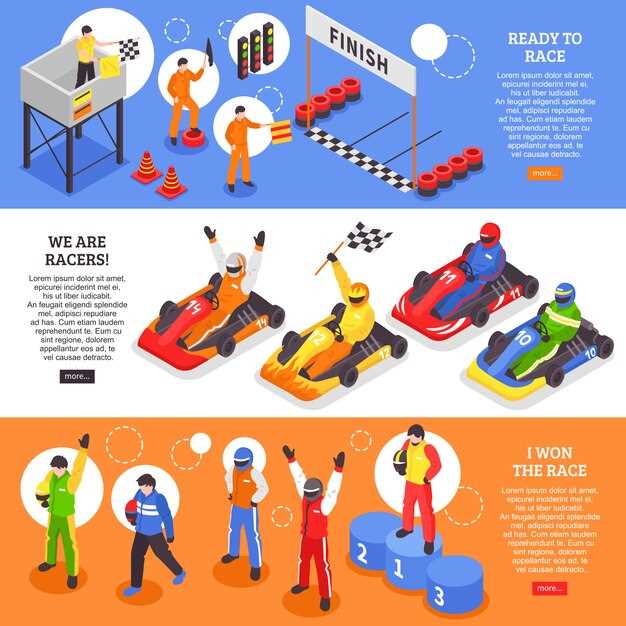
Entering the world of racing can be both exhilarating and intimidating for newcomers. As they start their journey on the track, many rookie racers are eager to prove themselves, yet often fall prey to a range of common mistakes that can hinder their performance. Understanding these pitfalls is crucial for any aspiring racer who aims to improve their skills and elevate their competitive edge.
One of the primary errors that beginners make is underestimating the importance of proper vehicle setup. New racers might jump into their cars without fully grasping the critical aspects of suspension tuning, tire pressures, and weight distribution. Neglecting these factors can lead to compromised vehicle handling, resulting in a poor racing experience and, ultimately, slower lap times.
Another frequent mistake is the lack of strategic pacing during races. Many new racers tend to push their limits too quickly in an attempt to gain an early advantage. However, failing to regulate speed and conserve tires can lead to fatigue and decreased lap performance as the race progresses. Learning to strike a balance between aggression and patience is essential for sustained success on the track.
Moreover, a significant gap in understanding arises when it comes to track awareness. New racers often focus solely on their own performance, neglecting the dynamics of the race around them. Failing to recognize the positioning of other competitors, potential hazards, and changing track conditions can lead to miscalculations and dangerous situations. Developing sharp situational awareness is vital for making informed decisions and enhancing overall safety.
Ignoring Proper Warm-Up and Stretching Techniques
Many new racers make the critical mistake of neglecting a proper warm-up and stretching routine before hitting the track. This oversight can lead to decreased performance and an increased risk of injury. Warm-ups are essential as they prepare the body for the physical demands of racing by gradually increasing heart rate, blood flow to muscles, and overall body temperature.
Dynamic stretching should be the focus of a warm-up, as it enhances flexibility and prepares muscles for the vigorous movements involved in racing. Static stretching, while beneficial, is best reserved for post-race sessions to avoid reducing muscle power at a crucial time.
Common warm-up exercises include leg swings, arm circles, and torso twists, which promote mobility and activate key muscle groups. These activities not only prevent stiffness but also improve coordination and response time, critical factors in racing performance.
Furthermore, a proper warm-up routine helps build mental focus. New racers often underestimate the psychological aspect of racing; preparing mentally alongside the physical can lead to improved decision-making and reaction times on the track.
In summary, integrating a thorough warm-up and appropriate stretching techniques into pre-race routines is vital for any new racer. It maximizes performance potential and minimizes the risk of injury, setting the foundation for a successful race experience.
Underestimating the Importance of Line and Cornering Skills

One of the most critical aspects of racing is mastering the racing line and cornering techniques. New racers often overlook this fundamental element, believing that simply having a fast car or good acceleration will suffice. However, understanding line and cornering can significantly impact lap times and overall performance.
The racing line is the optimal path around the track that minimizes lap time. It involves selecting the right entry, apex, and exit points for each corner. Many beginners tend to drift off the ideal line, which can lead to slower speeds and compromised stability. Here are some key factors to consider:
- Track Knowledge: Familiarizing yourself with the track layout is essential. Knowing the best lines around each corner can save valuable time.
- Apex Positioning: Hitting the apex– the innermost point of a corner– allows for a smoother exit and better speed on the straights.
- Corner Entry Speed: Entering corners too fast can lead to loss of control. Learn to brake early and carry optimal speed into the corner.
- Throttle Control: Smooth acceleration out of corners is vital. Applying power too early can cause oversteer, while waiting too long can lose momentum.
- Steering Technique: Use a consistent steering technique to maintain stability. Avoid abrupt inputs that can unsettle the car.
In addition to these factors, understanding weight transfer is crucial. When entering a corner, weight shifts occur, affecting tire grip. Here’s how to manage it:
- Brake early to shift weight to the front tires for better steering response.
- Gradually release the brakes at the corner’s entry to allow the rear tires to gain grip.
- Maintain smooth steering inputs to keep the car balanced through the turn.
Mastering line and cornering skills requires practice and patience. Spend time on the track to reinforce these techniques. Acknowledging their importance will lead to improved performance and a more enjoyable racing experience.
Neglecting Regular Vehicle Maintenance Before Races

One of the most critical mistakes new racers make is overlooking the importance of regular vehicle maintenance prior to race day. A well-maintained vehicle not only enhances performance but also ensures safety on the track. Common areas often neglected include checking fluid levels, tire condition, and brake functionality.
Engine oil should be analyzed, and changes made to avoid overheating or mechanical failure during a race. This includes checking coolant levels and ensuring the cooling system is in optimal condition. Ignoring these aspects can lead to engine seizure, resulting in not just a race loss but also expensive repairs.
Tires play a pivotal role in a vehicle’s grip and handling. New racers frequently underestimate the impact of tire pressure and tread depth. Properly inflated tires provide better traction, while adequate tread depth helps prevent skidding. Ignoring these factors can lead to compromised performance and a higher risk of accidents.
Brakes are another critical component that should never be overlooked. Ensuring that brake pads are not worn down and that the brake fluid is at the appropriate level is essential. Failure to maintain brakes can lead to reduced stopping power, which is detrimental when precision is crucial on the track.
In addition to mechanical aspects, a pre-race inspection should include a thorough check of electrical systems, including lights and sensors. An electrical issue could lead to race disqualification or, worse, an accident on the track. Consistently performing maintenance checks not only maximizes the vehicle’s performance but also instills confidence in the driver.
In conclusion, investing time in regular vehicle maintenance can significantly influence race outcomes. New racers should prioritize these checks as part of their preparation routine, recognizing that even minor oversights can lead to major setbacks during a race.

